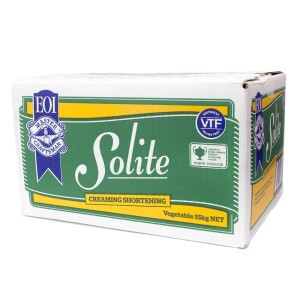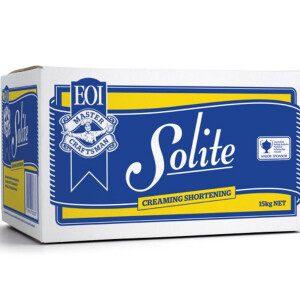You've probably come across the term shortening in recipes. But what exactly does it mean, and why is it such a staple in baking and decorating?
In essence, shortening is just any fat that’s solid at room temperature – think along the lines of butter, margarine, or lard. These are not usually suitable for vegetarians and vegans, so you can also get vegetable shortening, which is typically made of vegetable oils like soybean, palm or cottonseed that have been partially hydrogenated to make them solid. Shortening is particularly useful in recipes like pies, pastries and scones where you want a crisp, flaky texture rather than a rich, buttery one. It's also great to use in buttercream, but more on that below.
Some brand names of vegetable shortenings that you may recognise are: Solite, Trex, Crisco and Copha.
We have two types of shortening:
Solite Vegetable Shortening: All vegetable shortening. Suitable for vegetarians and vegans. Available in 500g tubs and 15kg boxes.
Solite Creaming Shortening: Vegetable and animal shortening. Contains animal fat so is not suitable for vegetarians and vegans. Available in 500g tubs and 15kg boxes.


In baking, the term shortening actually refers to its ability to "shorten" the texture of dough. This means it helps break down the long strands of gluten in flour, giving baked goods that light, crumbly texture. Bread dough is referred to as a "long dough" as the strands of gluten have been developed and lengthened to give bread the chewiness that we love.
Shortening has a higher melting point and doesn’t melt the same way butter does. This can be especially useful for pastry recipes where you need the dough to stay cold and firm before baking. Because it doesn’t contain water like butter, it creates a crispier texture in the finished product.
Creating flakiness: Want extra crispy pastry? Use some shortening! One of the main reasons shortening is a very useful product to have in the kitchen, particularly in pastry recipes, is its ability to create a flaky texture. When mixed with flour, shortening helps coat the flour particles, creating layers as the dough bakes. This leads to a tender, flaky pastry crust that is perfect for pies and croissants.
Light and tender cakes: Shortening can be used in cake recipes to create a light and tender crumb. It contributes to the softness and moisture of the cake, as the fat helps prevent the development of gluten. This is why shortening is often found in recipes for cakes like angel food cakes, cupcakes and pound cakes, where you want a delicate texture that’s not too dense.
Stability in high temperatures: Since shortening remains solid at room temperature, it’s more stable when exposed to heat compared to butter. This makes it an excellent choice for recipes that need a bit of extra heat stability, such as cookies and other baked goods. The texture of the finished product will hold up well even in a warm or humid environment.
Increased shelf life: Shortening can help extend the shelf life of baked goods. Its high-fat content prevents the rapid staling that can happen with products that use butter or oil. If you plan on storing baked goods for longer periods, shortening can help maintain their freshness.
Buttercream: One of the most common uses for shortening in cake decorating is in buttercream. Shortening is often added to buttercream to help the icing hold its shape and maintain a smooth, creamy texture. This is particularly useful in our hot summers, as it prevents the icing from melting or becoming too soft. Using vegetable shortening also means that vegans can enjoy the buttercream too!
Compared to butter, shortening has barely any flavour, so buttercream made with only shortening can lack some flavour. To help combat this, a lot of bakers use half butter and half shortening in their buttercreams to get the best of both worlds: better heat resistance from the shortening and the yummy taste from the butter.
It gives a whiter end result than using butter, so if you are after a crisp, white buttercream, shortening is the way to go.
Fondant: Shortening is also used to help make fondant more pliable and easier to work with. By kneading in a small amount of shortening, you can soften fondant and prevent it from cracking when it’s rolled out or moulded. It is the secret ingredient when extruding fondant too.
Covering Cakes: Smoothing shortening over your ganache before applying fondant is a great way to get the fondant to stick to the cake. Using jam or sugar syrup for this can get very sticky, but not so with shortening. Also, if you find you have to peel the fondant back, it's much easier to do. With sugar syrup, you're likely to take the ganache off too.
In the same vein, smooth shortening over your polystyrene dummy to get the fondant to stick, and then when you want to reuse the dummy, the fondant will easily pop back off the dummy. It's great for covering boards too.
While shortening offers several advantages, it’s important to remember that it’s not always the best choice for every recipe. If flavour is your main priority, butter might be the better option, as it provides a richer taste. However, for texture, stability, and the higher melting point, shortening is indispensable.
If you don't need to cater for vegans, you may be wondering why you wouldn't just use butter all the time - it is most delicious after all! Well, these are some advantages to using shortening and the key differences come down to fat content and consistency:
In conclusion, shortening is an essential ingredient for bakers and cake decorators who need structure, flakiness, and stability in their creations. From light cakes to perfectly piped frosting, shortening plays an important role in ensuring that your baked goods and decorations turn out just right. Whether you're making a fruit pie or decorating a wedding cake, this simple ingredient can make all the difference.